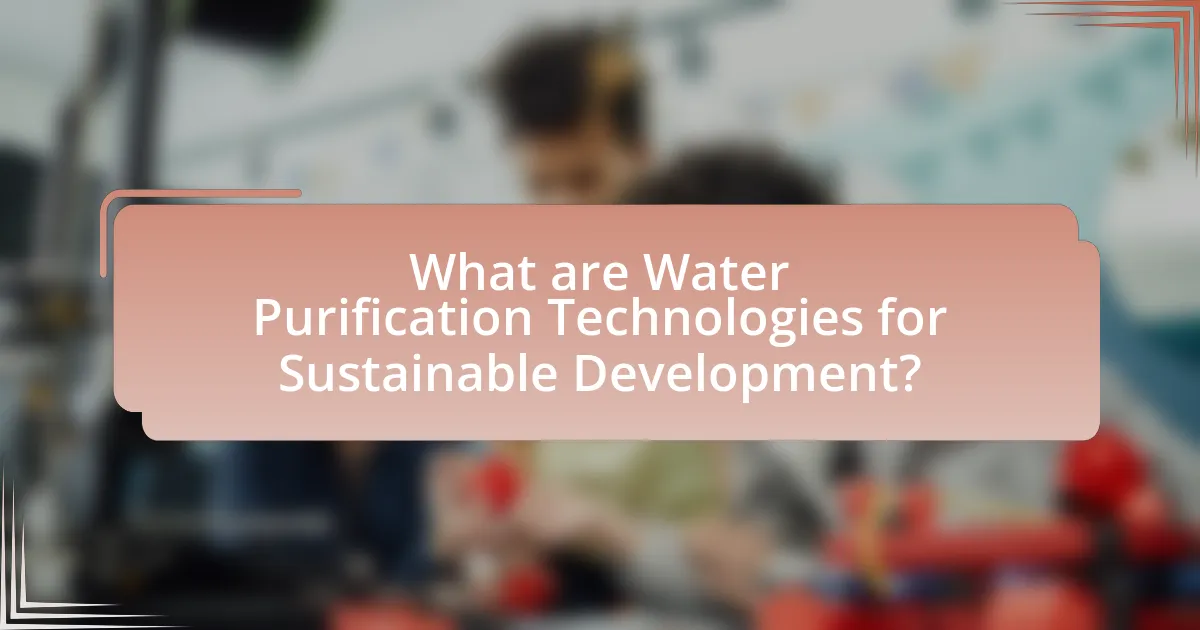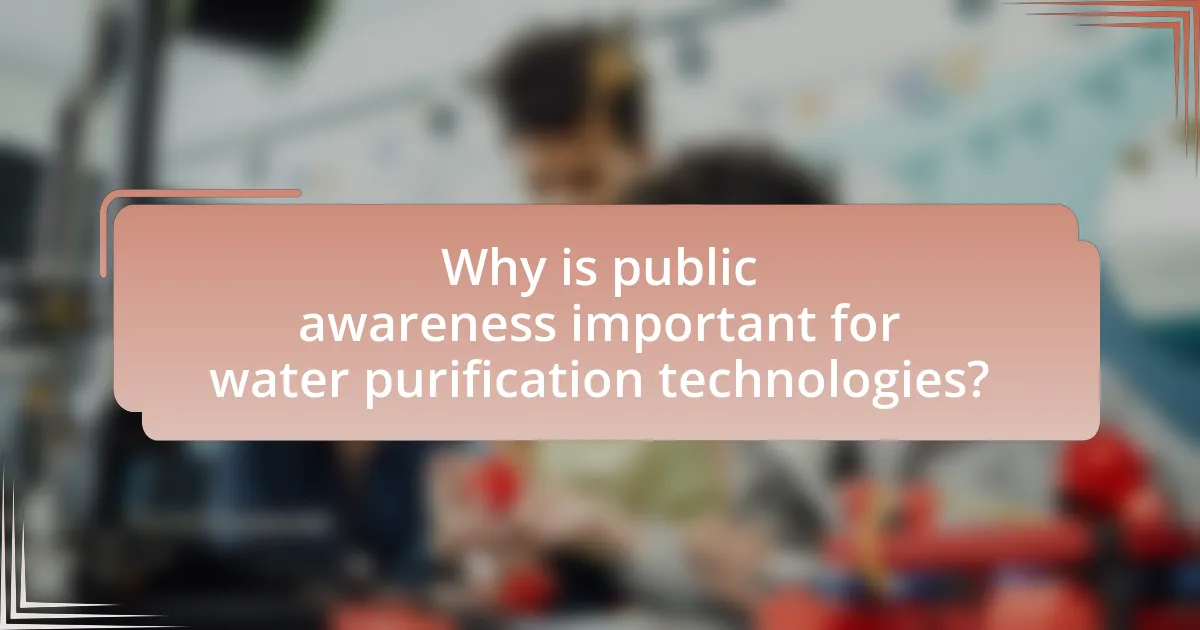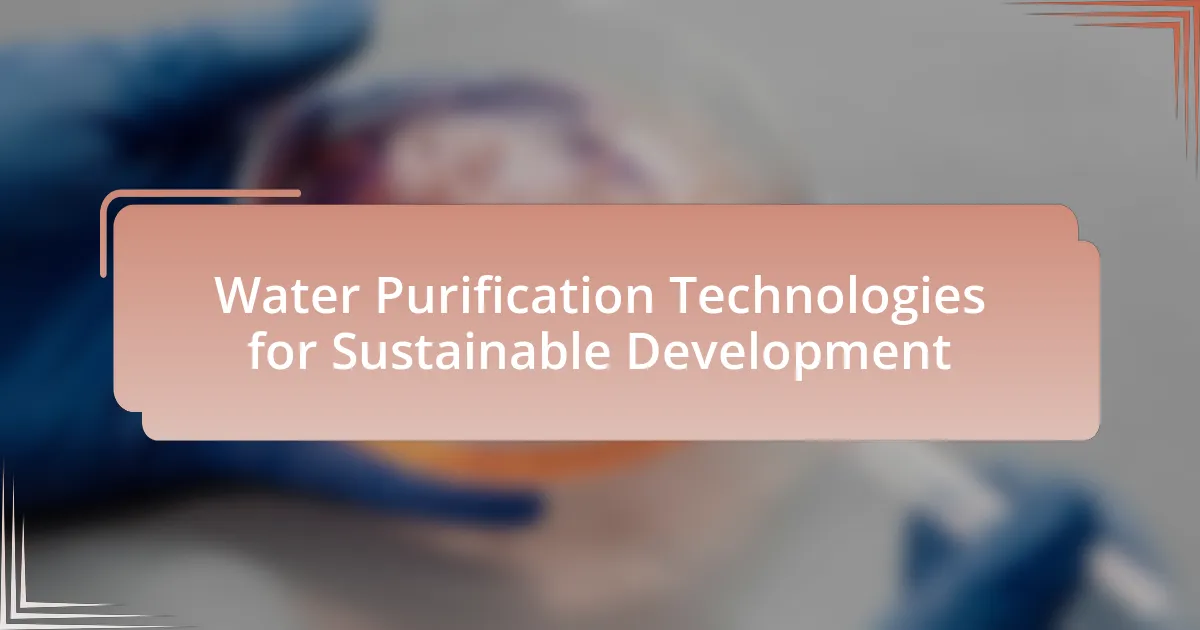Water purification technologies are critical for sustainable development, encompassing methods such as reverse osmosis, ultraviolet (UV) disinfection, and biofiltration. These technologies ensure access to clean drinking water, reduce health risks, and support environmental sustainability by minimizing pollution and promoting efficient water use. The article explores how these technologies contribute to public health, social equity, and ecological balance, while also addressing challenges such as operational costs and the removal of emerging contaminants. Additionally, it highlights the importance of community involvement and education in enhancing the effectiveness and sustainability of water purification initiatives.

What are Water Purification Technologies for Sustainable Development?
Water purification technologies for sustainable development include methods such as reverse osmosis, ultraviolet (UV) disinfection, and biofiltration. Reverse osmosis effectively removes contaminants by forcing water through a semi-permeable membrane, achieving high purification levels. UV disinfection utilizes ultraviolet light to eliminate pathogens without the use of chemicals, making it environmentally friendly. Biofiltration employs natural processes, using microorganisms to break down pollutants, promoting ecological balance. These technologies are essential for providing clean water, reducing health risks, and supporting sustainable practices in water management.
How do these technologies contribute to sustainable development?
Water purification technologies contribute to sustainable development by ensuring access to clean and safe drinking water, which is essential for health and well-being. These technologies reduce waterborne diseases, promote hygiene, and enhance the quality of life, particularly in underserved communities. For instance, the World Health Organization reports that improved water quality can reduce the incidence of diarrhea by up to 30%, significantly impacting public health. Additionally, sustainable water purification methods, such as solar water disinfection and biofiltration, minimize environmental impact by using renewable resources and reducing chemical pollutants. This alignment with sustainable practices supports the United Nations Sustainable Development Goal 6, which aims to ensure availability and sustainable management of water and sanitation for all.
What are the environmental benefits of water purification technologies?
Water purification technologies provide significant environmental benefits by reducing pollution, conserving ecosystems, and promoting sustainable water use. These technologies effectively remove contaminants from water sources, which decreases the levels of harmful substances entering rivers, lakes, and oceans, thereby protecting aquatic life and biodiversity. For instance, advanced filtration and treatment processes can eliminate pathogens and toxic chemicals, leading to cleaner water bodies that support healthier ecosystems. Additionally, by ensuring safe drinking water, these technologies reduce the reliance on bottled water, which in turn decreases plastic waste and lowers carbon emissions associated with production and transportation. Furthermore, efficient water purification systems can enhance water reuse and recycling, contributing to sustainable water management practices that are essential in addressing water scarcity issues.
How do these technologies support social equity in water access?
Water purification technologies support social equity in water access by providing affordable and sustainable solutions to communities lacking clean water. These technologies, such as solar water disinfection and biosand filters, enable low-income populations to access safe drinking water without relying on expensive infrastructure. For instance, the use of solar disinfection can reduce waterborne diseases by up to 90%, significantly improving health outcomes in marginalized communities. Additionally, decentralized systems empower local users to maintain and operate their water sources, fostering community ownership and resilience. This approach not only addresses immediate health needs but also promotes long-term social equity by ensuring that all individuals, regardless of socioeconomic status, have access to essential water resources.
What are the key types of water purification technologies?
The key types of water purification technologies include reverse osmosis, ultraviolet (UV) disinfection, activated carbon filtration, and distillation. Reverse osmosis utilizes a semipermeable membrane to remove contaminants, achieving up to 99% removal of dissolved solids. UV disinfection employs ultraviolet light to inactivate microorganisms, effectively eliminating pathogens without chemicals. Activated carbon filtration adsorbs impurities and improves taste and odor, making it effective for organic compounds. Distillation involves boiling water and condensing the steam to separate contaminants, ensuring high purity levels. These technologies are essential for providing safe drinking water and supporting sustainable development initiatives.
What is reverse osmosis and how does it work?
Reverse osmosis is a water purification process that removes contaminants from water by using a semipermeable membrane. In this process, water is forced through the membrane under pressure, allowing only water molecules to pass while blocking larger molecules, ions, and impurities. This method effectively reduces dissolved solids, bacteria, and other harmful substances, making it a widely used technology in both industrial and residential applications for producing clean drinking water. The effectiveness of reverse osmosis is supported by its ability to remove up to 99% of total dissolved solids, as demonstrated in various studies and practical implementations in water treatment facilities.
How does ultraviolet (UV) purification function?
Ultraviolet (UV) purification functions by using UV light to inactivate microorganisms in water, rendering them unable to reproduce and cause disease. The UV light, typically emitted by mercury vapor lamps or LEDs, penetrates the cell walls of bacteria, viruses, and protozoa, disrupting their DNA or RNA. This process effectively eliminates pathogens without the use of chemicals, making it an environmentally friendly option for water treatment. Studies have shown that UV purification can achieve a 99.99% reduction in harmful microorganisms, demonstrating its efficacy in ensuring safe drinking water.
What role does activated carbon play in water purification?
Activated carbon plays a crucial role in water purification by adsorbing contaminants and impurities from water. This material has a highly porous structure, which increases its surface area and allows it to effectively trap organic compounds, chlorine, heavy metals, and other pollutants. Studies have shown that activated carbon can remove up to 99% of certain contaminants, making it an essential component in various water treatment systems, including municipal water supplies and home filtration units. Its effectiveness is supported by research indicating that activated carbon filters significantly improve water quality by reducing harmful substances, thus contributing to sustainable water purification practices.
What challenges do water purification technologies face?
Water purification technologies face several significant challenges, including high operational costs, energy consumption, and the need for effective removal of emerging contaminants. High operational costs hinder widespread adoption, particularly in low-income regions, where financial resources are limited. Energy consumption remains a critical issue, as many purification methods require substantial energy input, contributing to environmental concerns and limiting sustainability. Additionally, the removal of emerging contaminants, such as pharmaceuticals and microplastics, poses a technical challenge, as conventional methods often fail to adequately address these pollutants, necessitating the development of advanced treatment solutions.
How do economic factors impact the adoption of these technologies?
Economic factors significantly influence the adoption of water purification technologies for sustainable development by determining the affordability and accessibility of these solutions. High initial costs and ongoing operational expenses can deter investment in advanced purification systems, particularly in low-income regions where financial resources are limited. For instance, a study by the World Bank indicates that countries with higher GDP per capita tend to invest more in water purification technologies, as they can allocate more funds towards infrastructure improvements. Additionally, economic incentives, such as government subsidies or grants, can enhance adoption rates by reducing financial barriers, as seen in various successful programs in developing nations that have increased access to clean water through financial support.
What are the technological limitations of current water purification methods?
Current water purification methods face several technological limitations, including inefficiency in removing certain contaminants, high operational costs, and energy consumption. For instance, conventional methods like chlorination and filtration may not effectively eliminate emerging pollutants such as pharmaceuticals and microplastics, which are increasingly found in water sources. Additionally, advanced techniques like reverse osmosis, while effective, require significant energy input and can lead to high operational costs, making them less accessible for widespread use, particularly in developing regions. Furthermore, many purification systems generate waste byproducts that require additional treatment, complicating the overall process. These limitations highlight the need for ongoing research and innovation in water purification technologies to enhance their effectiveness and sustainability.

How can water purification technologies be implemented effectively?
Water purification technologies can be implemented effectively by integrating advanced filtration systems, such as reverse osmosis and UV disinfection, into existing water supply infrastructures. These technologies enhance water quality by removing contaminants and pathogens, ensuring safe drinking water. For instance, reverse osmosis can remove up to 99% of dissolved salts and impurities, while UV disinfection can eliminate 99.99% of bacteria and viruses. Successful implementation also requires training local operators, establishing maintenance protocols, and securing funding for infrastructure upgrades, as evidenced by projects in countries like India and Kenya, where community engagement and government support have led to improved water access and quality.
What are the best practices for deploying water purification systems?
The best practices for deploying water purification systems include conducting a thorough needs assessment, selecting appropriate technology based on local water quality and availability, ensuring community involvement, and implementing regular maintenance protocols. A needs assessment identifies specific contaminants and water sources, guiding the choice of technology, such as reverse osmosis or UV treatment, which must align with the local context. Community involvement fosters ownership and ensures the system meets user needs, while regular maintenance is crucial for long-term functionality and reliability. According to the World Health Organization, effective maintenance can reduce system failures by up to 30%, highlighting its importance in sustainable deployment.
How can communities ensure the sustainability of these systems?
Communities can ensure the sustainability of water purification systems by implementing regular maintenance, promoting community involvement, and utilizing local resources. Regular maintenance ensures that the systems operate efficiently and effectively, reducing the risk of breakdowns and contamination. Community involvement fosters a sense of ownership and responsibility, encouraging residents to actively participate in monitoring and maintaining the systems. Utilizing local resources, such as rainwater harvesting and natural filtration methods, can enhance sustainability by reducing reliance on external inputs and promoting environmental stewardship. Studies show that community-managed water systems have a higher success rate in sustainability, as evidenced by the success of projects in rural areas of India, where local governance and community engagement led to improved water quality and system longevity.
What role do local governments play in supporting water purification initiatives?
Local governments play a crucial role in supporting water purification initiatives by implementing policies, providing funding, and facilitating community engagement. They establish regulations that promote sustainable water management practices and often allocate budgetary resources to support the development and maintenance of water purification systems. For instance, local governments may partner with organizations to secure grants or subsidies aimed at enhancing water quality. Additionally, they engage the community through educational programs that raise awareness about the importance of clean water and encourage public participation in water conservation efforts. This multi-faceted approach ensures that water purification initiatives are effectively integrated into local infrastructure and community practices, ultimately contributing to sustainable development goals.
What innovations are emerging in water purification technologies?
Emerging innovations in water purification technologies include advanced filtration systems, solar-powered purification, and nanotechnology applications. Advanced filtration systems, such as membrane bioreactors, combine biological treatment with membrane filtration to enhance efficiency and reduce energy consumption. Solar-powered purification utilizes solar energy to drive processes like distillation and photocatalysis, making it sustainable and cost-effective. Nanotechnology applications involve the use of nanomaterials to improve contaminant removal efficiency, with studies showing that nanoparticles can effectively eliminate pathogens and heavy metals from water. These innovations are crucial for addressing global water scarcity and ensuring access to clean water.
How is nanotechnology enhancing water purification processes?
Nanotechnology enhances water purification processes by utilizing nanoparticles to improve filtration efficiency and contaminant removal. For instance, silver nanoparticles exhibit antimicrobial properties, effectively eliminating bacteria and viruses from water, while carbon nanotubes can filter out heavy metals and organic pollutants due to their high surface area and adsorption capabilities. Research published in the journal “Environmental Science & Technology” by researchers at the University of California demonstrated that nanomaterials can reduce contaminants by over 90%, showcasing their effectiveness in real-world applications.
What are the potential benefits of solar-powered water purification?
Solar-powered water purification offers significant benefits, including reduced energy costs, environmental sustainability, and improved access to clean water. By utilizing solar energy, this technology minimizes reliance on fossil fuels, leading to lower operational expenses and a smaller carbon footprint. Additionally, solar-powered systems can be deployed in remote or underserved areas, providing essential access to safe drinking water where traditional infrastructure may be lacking. Studies indicate that solar water purification can effectively eliminate pathogens and contaminants, enhancing public health outcomes in communities that adopt this technology.

Why is public awareness important for water purification technologies?
Public awareness is crucial for water purification technologies because it drives community engagement and support for sustainable practices. When individuals understand the importance of clean water and the technologies available to achieve it, they are more likely to advocate for and adopt these solutions. For instance, studies show that communities with higher awareness levels about water quality issues are more proactive in implementing purification systems, leading to improved public health outcomes. Additionally, informed citizens can influence policy decisions, ensuring that water purification technologies receive necessary funding and attention from local governments.
How can education improve the adoption of water purification technologies?
Education can improve the adoption of water purification technologies by increasing awareness and understanding of their benefits and functionalities. When individuals are educated about the health risks associated with contaminated water and the effectiveness of purification methods, they are more likely to invest in and utilize these technologies. For instance, studies show that communities with educational programs on water safety and purification report higher rates of technology adoption, as seen in initiatives by organizations like UNICEF, which emphasize the importance of education in promoting health and sanitation practices. This correlation highlights that informed individuals are more inclined to embrace innovative solutions for clean water access.
What strategies can be used to raise awareness about water purification?
To raise awareness about water purification, educational campaigns can be implemented in schools and communities. These campaigns can include workshops, seminars, and interactive demonstrations that highlight the importance of clean water and the methods of purification. Research indicates that hands-on learning experiences significantly enhance retention of information, making participants more likely to adopt water purification practices in their daily lives. Additionally, leveraging social media platforms to share informative content, success stories, and visual demonstrations can reach a broader audience, as studies show that social media is a powerful tool for spreading awareness on public health issues. Collaborating with local organizations and influencers can further amplify the message, ensuring that it resonates with diverse demographics.
How can community involvement enhance the effectiveness of water purification initiatives?
Community involvement enhances the effectiveness of water purification initiatives by fostering local ownership and ensuring that solutions are tailored to specific needs. When communities actively participate in the planning and implementation of water purification projects, they are more likely to adopt and maintain these systems, leading to higher success rates. For instance, a study published in the Journal of Environmental Management found that community-led initiatives in rural areas resulted in a 30% increase in the sustainability of water purification systems compared to top-down approaches. This involvement also facilitates knowledge sharing and capacity building, empowering residents to manage and troubleshoot systems effectively, which further contributes to long-term success.
What practical steps can individuals take to support water purification efforts?
Individuals can support water purification efforts by implementing simple yet effective actions such as conserving water, participating in local clean-up initiatives, and advocating for sustainable practices. Conserving water reduces the strain on water resources, which is crucial for maintaining clean water supplies. Engaging in community clean-up events helps remove pollutants from local water bodies, directly improving water quality. Additionally, advocating for policies that promote sustainable water management and supporting organizations focused on water purification technologies can amplify individual efforts. According to the United Nations, sustainable water management is essential for achieving clean water and sanitation for all, highlighting the importance of collective action in this area.
How can individuals contribute to local water purification projects?
Individuals can contribute to local water purification projects by volunteering their time and skills to assist in the implementation and maintenance of purification systems. Engaging in community clean-up events, fundraising for water purification technologies, and educating others about the importance of clean water are effective ways to support these initiatives. For instance, a study by the World Health Organization indicates that community involvement in water projects significantly enhances sustainability and effectiveness, as local knowledge and participation lead to better outcomes in water quality management.
What are some simple water purification methods that can be used at home?
Some simple water purification methods that can be used at home include boiling, using a water filter, and solar disinfection. Boiling water for at least one minute effectively kills bacteria, viruses, and parasites, making it safe for consumption. Water filters, such as activated carbon filters, can remove contaminants and improve taste. Solar disinfection involves filling clear plastic bottles with water and placing them in direct sunlight for six hours, which can eliminate pathogens through UV radiation. These methods are widely recognized for their effectiveness in improving water quality and ensuring safety for drinking.


